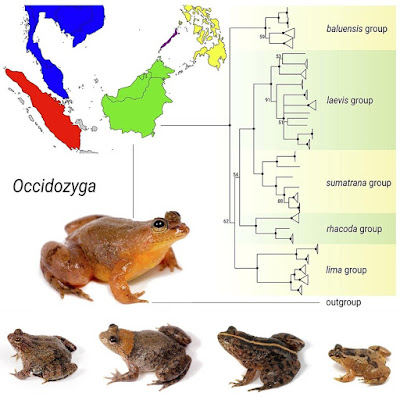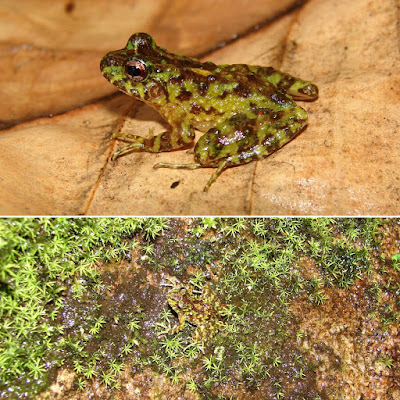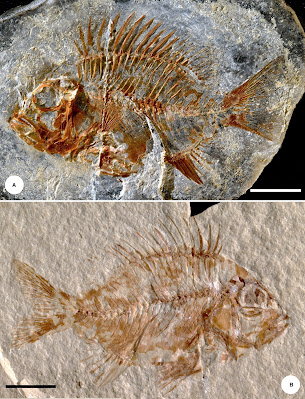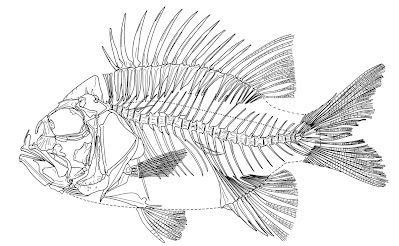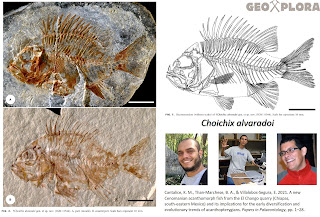[Most Recent Entries] [Calendar View]
Thursday, July 15th, 2021
| Time | Event | ||
| 2:20a | [Herpetology • 2021] Occidozyga • Unexpectedly High Levels of Lineage Diversity in Sundaland Puddle Frogs (Anura: Dicroglossidae)
Highlights: • Unexpectedly high genetic diversity was found in puddle frogs from Southeast Asia. • Presence of 29 evolutionary lineages possibly indicates cryptic species diversity. • Complex paleogeography resulted in allopatric, sympatric and parapatric distribution. • The Philippines, Palawan and Sumatra were independently colonized from Borneo. Abstract One of the most urgent contemporary tasks for taxonomists and evolutionary biologists is to estimate the number of species on earth. Recording alpha diversity is crucial for protecting biodiversity, especially in areas of elevated species richness, which coincide geographically with increased anthropogenic environmental pressures - the world’s so-called biodiversity hotspots. Although the distribution of Puddle frogs of the genus Occidozyga in South and Southeast Asia includes five biodiversity hotspots, the available data on phylogeny, species diversity, and biogeography are surprisingly patchy. Samples analyzed in this study were collected throughout Southeast Asia, with a primary focus on Sundaland and the Philippines. A mitochondrial gene region comprising ~ 2000 bp of 12S and 16S rRNA with intervening tRNA Valine and three nuclear loci (BDNF, NTF3, POMC) were analyzed to obtain a robust, time-calibrated phylogenetic hypothesis. We found a surprisingly high level of genetic diversity within Occidozyga, based on uncorrected p-distance values corroborated by species delimitation analyses. This extensive genetic diversity revealed 29 evolutionary lineages, defined by the > 5% uncorrected p-distance criterion for the 16S rRNA gene, suggesting that species diversity in this clade of phenotypically homogeneous forms probably has been underestimated. The comparison with results of other anuran groups leads to the assumption that anuran species diversity could still be substantially underestimated in Southeast Asia in general. Many genetically divergent lineages of frogs are phenotypically similar, indicating a tendency towards extensive morphological conservatism. We present a biogeographic reconstruction of the colonization of Sundaland and nearby islands which, together with our temporal framework, suggests that lineage diversification centered on the landmasses of the northern Sunda Shelf. This remarkably genetically structured group of amphibians could represent an exceptional case for future studies of geographical structure and diversification in a widespread anuran clade spanning some of the most pronounced geographical barriers on the planet (e.g., Wallace’s Line). Studies considering gene flow, morphology, ecological and bioacoustic data are needed to answer these questions and to test whether observed diversity of Puddle frog lineages warrants taxonomic recognition. Keywords: Cryptic species, Species delimitation, Phylogeny, Biogeography, Divergence time estimation, Anura Conclusion: Our preferred temporal framework based on mitochondrial substitution rates of the diversification of Occidozyga described in this study is generally consistent with the reconstruction of the paleogeography of Southeast Asia. The resulting scenario incorporates a complex spatio-temporal pattern of subsequent vicariance and dispersal events starting from today's Borneo caused by plate tectonics, orogeny, and climatic oscillations resulting in sea level fluctuations. De Bruyn et al. (2014) conducted a meta-analysis of phylogenetic studies in different groups of organisms from Southeast Asia and found a statistically higher level of diversity in Borneo and Indochina compared to Java and Sumatra. The long period of relative tectonic and climatic stability of northern Sundaland, including Borneo, for instance, was inferred by these authors as having paved the way for high levels of in situ diversification (de Bruyn et al., 2014). The uplift of mountain ranges, changes in the course of drainage systems and oscillating moderate climatic changes, probably altered the distribution of vegetation types like forests and savannah, separated populations temporarily and triggered subsequent allopatric speciation (Cannon et al., 2012, Heaney, 1991, van der Kaars and De Deckker, 2002). De Bruyn et al. (2014) argue that these highly diverse regions, Borneo and Indochina, have acted as sources of biodiversity for the remaining parts of Sundaland and the adjacent regions, which were colonized later in the Pliocene and Pleistocene. The evolutionary pattern detected in Occidozyga agrees markedly well with such an ‘Out-of-Borneo’ source of evolutionary lineages hypothesis, although diversification began some considerable time before the Pliocene and Pleistocene. In this study, we propose a scenario in which Borneo, as the largest part of northern Sundaland, was the geographic origin of the highest diversity of Occidozyga evolutionary lineages. From Borneo, the surrounding landmasses of the Sunda Shelf, Palawan, and the remaining Philippine archipelago were subsequently colonized by single dispersal events. Jana M. Flury, Alexander Haas, Rafe M. Brown, Indraneil Das, Pui Yong Min, Kueh Boon-Hee, Ulrich Scheidt, Djoko T. Iskandar, André Jankowski and Stefan T. Hertwig. 2021. Unexpectedly High Levels of Lineage Diversity in Sundaland Puddle Frogs (Dicroglossidae: Occidozyga Kuhl and van Hasselt, 1822). Molecular Phylogenetics and Evolution. 163, 07210. DOI: 10.1016/j.ympev.2021.107210 | ||
| 2:21a | [Herpetology • 2021] Thoropa bryomantis • A New Species of Thoropa Cope, 1865 (Anura, Cycloramphidae) from the Serra da Mantiqueira, Southeast Brazil
Abstract We describe a new species of Thoropa, previously identified as T. lutzi, from the northern region of the Serra da Mantiqueira in the Atlantic Forest domain in Southeast Brazil. The new species is diagnosed by the following combination of characters: small size; slender body; head longer than wide; dark colored nuptial pads on the inner side of the Finger I and on the internal carpal tubercle; nuptial pads with epidermic cone-shaped papillae measuring of 53.1–91.6 μm in diameter, and at a density of 14–32 papillary epidermic projections/mm2; presence of vocal sac and vocal slits; and advertisement call with 5–10 harmonics, duration of 0.23–0.42 s, and peak of frequency of 2060–4470 Hz. With the description of the new species, T. lutzi is now only known for the state of Rio de Janeiro. Keywords: Amphibia, Atlantic Forest, bioacoustics, morphology, rock frog, taxonomy Thoropa bryomantis Clodoaldo Lopes Assis, João Victor A. Lacerda, Carla Silva Guimarães, Marco Antônio Peixoto, Maria Celeste Luna and Renato Neves Feio. 2021. A New Species of Thoropa Cope, 1865 (Anura, Cycloramphidae) from the Serra da Mantiqueira, Southeast Brazil. Zootaxa. 4996(3); 505-522. DOI: 10.11646/zootaxa.4995.3.6 | ||
| 7:37a | [PaleoIchthyology • 2021] Choichix alvaradoi • A New Cenomanian Acanthomorph Fish from the El Chango quarry (Chiapas, south-eastern Mexico) and Its Implications for the early Diversification and Evolutionary Trends of Acanthopterygians
Abstract A new Cenomanian spiny-rayed fish from El Chango quarry, Chiapas, south-eastern Mexico is described and included, together with †Zoqueichthys carolinae and †Pepemkay maya, in the most recent phylogenetic analysis of acanthomorph fishes encompassing both extant and extinct taxa. The topologies recovered from the parsimony phylogenetic analysis using both multistate (or composite), and contingent (or reductive), coding are compared, along with a Bayesian estimation. All the analyses corroborate the placement of †Z. carolinae in the Lampripterygii, while both †Choichix alvaradoi gen. et sp. nov. and †P. maya are considered to be incertae sedis members of the Acanthopterygii. Although no apomorphic character states for †C. alvaradoi were found, the unique combination of features supports the description of a new genus and species for the Upper Cretaceous of Mexico. The species herein described is the earliest diverging acanthopterygian lineage. The most outstanding character found is the absence of a true pelvic fin spine, which, together with its placement in the phylogenetic analysis, suggests the independent acquisition of the pelvic fin spine in both paracanthopterygians and acanthopterygians from a segmented first soft ray. This extinct taxon therefore plays an important part in our understanding of both fish diversity through time and the early steps in the diversification of acanthopterygians. Keywords: Acanthomorpha. acanthopterygian. Cenomanian. Chiapas. Mexico. phylogenetic analysis Systematic palaeontology Superclass: ACTINOPTERYGII Woodward, 1891 Infraclass: TELEOSTEI Müller, 1845 Subsection: ACANTHOMORPHATA Rosen, 1973 Division: ACANTHOPTERYGII sensu Betancur-R et al. 2017 Genus: †CHOICHIX nov. Derivation of name: The genus name is the combination of two words in the Tzotzil language: ‘Choy’ (= fish) and ‘Ch'ix’ (= spines), in reference to the number of spines in both dorsal and anal fins. Type species: IGM 11544, †Choichix alvaradoi gen. et sp. nov. †Choichix alvaradoi sp. nov. Derivation of name: The species name is a Latinization of the name Alvarado, in honour of Dr Jesús Alvarado Ortega, who devotes most of his life to understanding Mexican palaeodiversity and to teaching students and young researchers. The genus and species names together mean ‘the spiny-finned fish of Alvarado’. Holotype: IGM 11544, unique specimen preserved in part and counterpart. Type locality and horizon: El Chango quarry, ..., Ocozocoautla de Espinosa Municipality, Chiapas State, south-eastern Mexico, Cintalapa Formation of Sierra Madre Group (Moreno-Bedmar et al. 2014). Kleyton Magno Cantalice, Bruno Andrés Than-Marchese and Eduardo Villalobos-Segura. 2021. A New Cenomanian Acanthomorph Fish from the El Chango quarry (Chiapas, south-eastern Mexico) and Its Implications for the early Diversification and Evolutionary Trends of Acanthopterygians. Papers in Palaeontology. DOI: 10.1002/spp2.1359 |
| << Previous Day |
2021/07/15 [Calendar] |
Next Day >> |
